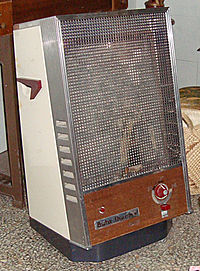
Photo from wikipedia
ABSTRACT A computer model capable of predicting the thermodynamic properties that occur inside a rigid container during both a non-vented or vented gas explosion is described. The model applies the… Click to show full abstract
ABSTRACT A computer model capable of predicting the thermodynamic properties that occur inside a rigid container during both a non-vented or vented gas explosion is described. The model applies the conservation of mass, energy, and momentum of the combustion gases and the motion of a rigid mass that covers an opening to the enclosure. The computer model differs from others examining similar problems by using a complete energy equation applied to the combustion gases and it includes temperature and pressure varying properties and heat transfer from combustion zone to the enclosure. The fundamental equations are non-dimensionalized resulting in two dimensionless groups that can be used to design an enclosure that will control or mitigate the effects of an explosion. Model results are compared with available experimental measurements of enclosure pressures for vented and non-vented explosions. The model closely predicts the transient pressure rise for explosions of hydrogen, methane, and mixtures of those two gases in a wide range of gas concentrations and for a variety of vessel and vent geometries.
Journal Title: Combustion Science and Technology
Year Published: 2017
Link to full text (if available)
Share on Social Media: Sign Up to like & get
recommendations!